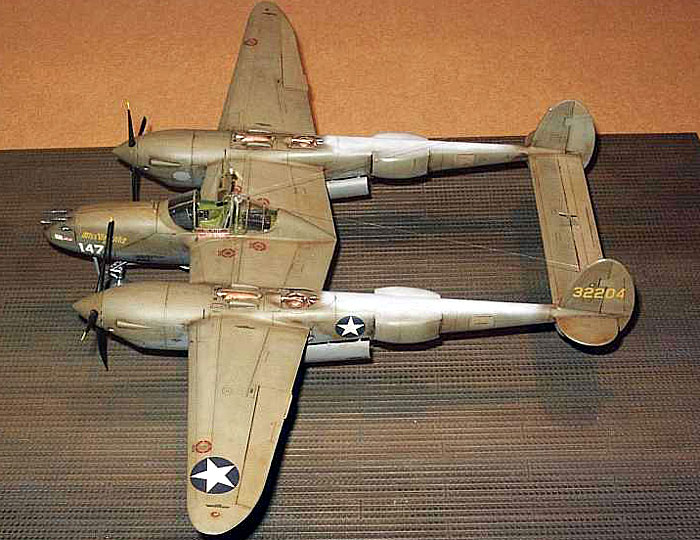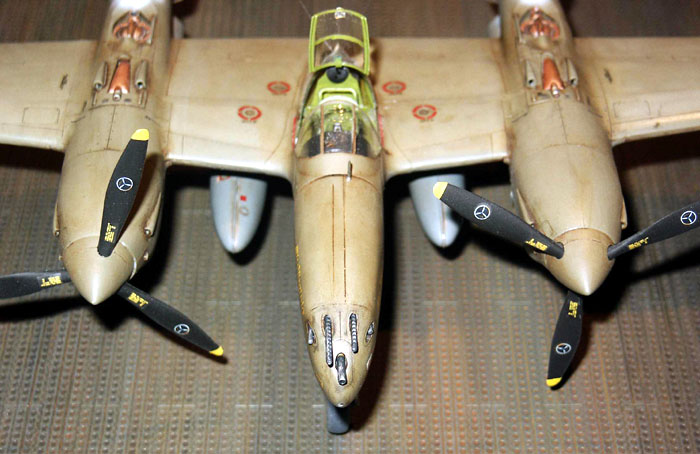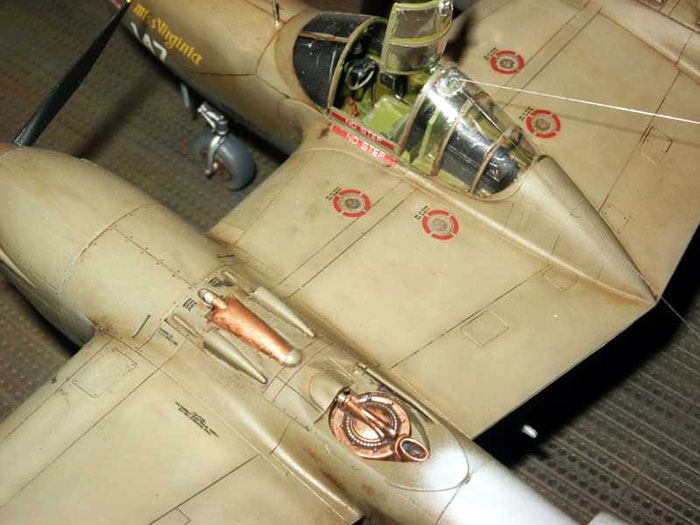|
Rex Barber's Yamamoto Mission
P-38 Lightning
by
Rian Jones
|

|
|
Lockheed P-38 Lighting |

HyperScale is proudly supported by
Squadron
I enjoy
modeling specific aircraft of historical significance. The events
surrounding the death of Admiral Isoruku Yamamoto have always fascinated
me ever since I read Burke Davis’ book “Get Yamamoto” over 30 years ago.
April 18, 2003 was the 60th anniversary of the mission; I had a
renewed interest and wanted to build models of the aircraft involved in
that event. Fortunately two very good kits exist in 1/48 scale of the
aircraft involved; Tamiya’s G4M1 Betty Bomber and the Hasegawa (Pro
Modeler) P-38F/G/H. The only problem was that decals depicting the exact
aircraft were no longer in print. Hyperscale to the rescue. A post on
the Plane Talking board led me to a deal with Bill Smith for a set of
decals from Mustang’s Aces series depicting both the Betty and the P-38.
(Thanks again Bill!) I acquired the kits and after 6 months of working on
again, off again, completed both the Betty and the P-38.
Background
Unknown to the
Japanese, the American Code Breakers (Code Name “Magic”) had broken the
Japanese Navy’s JN-25 code and its variants. This proved to be a great
advantage to the outnumbered American forces in the early stages of the
war in the Pacific and helped secure a victory at Midway, arguably the
turning point of the war in the Pacific for the Allied Forces. In April
1943, US Naval Intelligence intercept of one seemingly innocuous message
that helped to change the course of the war and to extract revenge for the
Japanese surprise attack on Pearl Harbor. The message detailed the
movements of Admiral Isoruku Yamamoto, supreme commander of the Japanese
combined fleet and the planner of the attack on Pearl Harbor, and his plan
to inspect the forward troops on Bougainville and Shortland Islands on
April 18, 1943. The message read: “0600 depart Rabaul by medium attack
plane (accompanied by six fighters). 0800 arrive Ballale. Depart
immediately for Shortland by sub-chaser (1st Base Force will
prepare one boat), arriving Shortland 0840…” The remainder of the
message contained further details of the Admiral’s trip, but the important
part was that the Navy knew exactly when and where he would arrive and
with what accompanying escort places. Admiral Chester W. Nimitz did not
take long to order a strike to take out Yamamoto. That decision was
backed up by both Secretary of the Navy Frank Knox and President Franklin
D. Roosevelt. The message ordering the mission from Secretary Knox
stated, “SQUADRON 339 P-38 MUST AT ALL
COSTS REACH AND DESTROY. PRESIDENT ATTACHES EXTREME IMPORTANCE TO
MISSION.”
The Navy had no
aircraft capable of performing the mission. The closest airfield was in
Guadalcanal, 400 flight miles from Bouganville. Stationed there was the
Army Air Corps 339th Fighter Squadron and their P-38 Lightnings,
the only aircraft in theater capable of reaching the intercept point, and
then only with specially fitted long range auxiliary drop tanks. The plan
called for 18 P-38’s to fly an over water route to avoid detection by
Japanese observation posts on the islands in between. The mission would
be flown at wave top level (30 feet off the deck) until the last possible
minute. Four pilots were assigned to the “killer group” including Rex
Barber and Tom Lanphier. The rest would fly top cover in two groups.
(Because of mechanical failures, only 16 planes actually made the
flight.) Even with the extra large drop tanks, they estimated that they
would only have enough fuel to linger over the intercept area for 10
minutes. A risky plan to be sure. Everything had to come together for
the plan to succeed. And succeed it did.

At 0700 on 18 April 1943, the P-38’s took off from
Guadalcanal and headed north to Bougainville. At 0800 Admiral Yamamoto
took off from Rabaul. Yamamoto and his staff were flying in two new G4M1
Betty Bombers accompanied by 6 Zeros. With a combination of excellent
flying, dead reckoning navigation and good luck, the two flights arrived
over the southwest corner of Bougainville at exactly the same time, 0934.
The 339th broke radio silence, “Bogeys at Eleven O’clock
high!” The P-38’s dropped tanks and went full throttle to the attack, all
except for Frank Holmes and Besby Hine. Hine couldn’t get his tanks to
jettison and flew away to attempt to shake them loose. Holmes, his
wingman, followed. That left only Barber and Lanphier to attack the
Betty’s. As they bored in on the lead Betty, the Zeros attacked.
Lanphier turned left and headed straight on into the Zeros, scattering
them, leaving Barber free to press his attack home. As he rolled in on
the Betty, he noticed that it was shiny and new looking. The P-38 had 4
.50 caliber machine guns and one 20mm canon in the nose. With this
devastating firepower, Barber raked the wing of the Betty from left to
right and pounded the right engine until it smoked and belched flames.
The Betty slowed and stalled, and tipped sharply to the right, the kind of
maneuver that a plane does when its pilot is killed. Barber thought he
was going to collide with the Betty and pulled up sharply. He never saw
the Betty go in, but when he looked back over his shoulder, he could see a
plume of smoke rising from the jungle where the plane had crashed. By
then the Zeros had caught up with Barber and were on his tail. He pressed
full throttle and out ran them, arriving back at the airfield with fumes
in his tanks and over 100 bullet holes in his P-38.
To this day there is controversy over who actually
shot down Yamamoto. Lanphier claimed the victory upon his return to
Guadalcanal, but the latter facts and investigation tend to support Rex
Barber’s claim. For example, Lanphier described shooting the wing off of
the Betty. The wreck of Yamamoto’s Betty is still there on the hillside
in Bougainville and neither wing is shot off. Both Barber and Lanphier
have passed away. Officially, the Air Force credits each man with half a
kill for Yamamoto’s Betty. Regardless of the controversy, Lanphier
deserves credit for his brave maneuver that set up Barber’s kill. Turning
into a pack of 6 Zeros that are attacking is a very brave thing to do and
allowed Barber the time to “make the kill.”
I have modeled “Miss Virginia” the P-38 flown by Rex
Barber on that mission because I believe it is now widely accepted that
Barber, not Lanphier, shot down Yamamoto. For more information on this
controversy see The Second Yamamoto Mission web site at:
http://www.syma.org/tball.asp

Figure 1 The routes of Admiral
Yamamoto and the 339th P-38s
Tamiya G4M1 Betty
(1/48 Scale)
I built Tamiya’s G4M1 Betty using the decals from the
Mustang sheet to mark it as 323, the bomber/transport carrying Admiral
Yamamoto.
Before submitting this article, Bob McElroy’s article
on his build of Yamamoto’s Betty was published on Hyperscale. He did an
excellent job, so I will refer you to that article instead of submitting
photos of my Betty.
http://hsfeatures.com/yamamotosbettybm_1.htm
To be honest, if I didn’t have an interest in the
history of this mission, I probably never would have purchased and built
Tamiya’s Betty Bomber. It’s big and expensive. I am glad that I did. It
is an outstanding kit, even if it does take up a lot of space in my
display case.
Hasegawa
P-38F/G/H (1/48 Scale)
I had heard bad things about this kit and was a
little gun shy when I started construction. But I soon decided that I
made the right choice (the other choice being the Academy kit). This kit
was built essentially OOB with the addition of the Mustang decals (I used
the kit decals for the stenciling).

Hasegawa offers a clear part to attach underneath the
tail to prop the plane up. I thought this looked cheap so I elected to
stuff the nose of this bird with lead fishing sinkers to prevent tail
sitting. About 6 ounces did the trick. Instead of right/left splitting
the gondola, Hasegawa made it more complicated. It fits together like a
clamshell, upper/lower and the nose cone is a separate part (no doubt to
allow for common parts for later versions). This left an unsightly seam
across the access panels for the guns. I filled, sanded and rescribed the
panel lines here. This was the only area that required any major
bodywork.
The canopy is a problem too. The P-38 has roll down
side windows like an automobile. Hasegawa has molded the canopy assembly
in five separate parts, front, rear, two sides and the top. Trying to
build a closed canopy bird is next to impossible without using a vac
formed part. Displaying it with the side windows down was not a problem
since in real life they disappear into the sidewalls of the cockpit. I
cut two strips of Evergreen plastic to size, painted and applied the “No
Step” decals. Voila’! open side windows. The lid was another challenge.
It kept breaking off with the slightest touch. I built a “hinge” from
Evergreen plastic, drilled small holes in the canopy frame and
corresponding holes in the hinge and used stretched sprue and CA glue to
“rivet” the canopy in place. It worked like a charm.
Painting this model presented a small challenge
also. The standard OD paint faded fast and severely in the South
Pacific. Using my trusty Iwata HP-CR, I preshaded all of the panel lines
with straight Model Master Acrylic OD. I then added 20% Flat White to the
OD and filed in the panels. I lightened the mix again with Flat White and
sprayed the fabric-covered surfaces to simulate their fading at a
different rate than the metal. On the fourth pass I added about 10% more
Flat White, thinned the mixture 50/50 with 91% rubbing alcohol and lightly
oversprayed the entire upper surface.

The bottom surfaces were painted Model Master Acrylic
Neutral Gray with 10% Flat White added for scale effect. The demarcation
line is freehand. I then applied 3 coats of Future and then decals.
After the decals were dry I applied several coats of Model Master
semigloss lacquer. I weathered this aircraft extensively using Windsor
Newton Burnt Umber oil paint applied with a broad brush working into the
panel lines and then wiped off with a soft rag.
I airbrushed the exhaust stains that are ever present
on P-38’s using Tamiya Light Gray, thinned 25/75 with alcohol. The
superchargers and exhausts were first painted Model Master nonbuffing
steel. Then a wash of Tamiya Flat Red Brown was used to simulate
oxidation. The whole thing was then over coated with several coats of
Model Master Flat Lacquer. Antenna wires were added using 2-lb. test
nylon fly fishing line.
-
Burke Davis, Get Yamamoto, Random House, 1969
-
P-38 Walk Around, Squadron Signal Publications
-
Mitsubishi Type 1 Rikko 'Betty' Units of World War 2, Osprey
Publishing Ltd
-
Lightning Over Bougainville, Smithsonian Institution Press, 1991
Click on the thumbnails
below to view larger images:
Model, Images and Text
Copyright © 2004 by
Rian Jones
Page Created 11 March, 2004
Last Updated
11 March, 2004
Back to
HyperScale Main Page |
Home
| What's New |
Features |
Gallery |
Reviews |
Reference |
Forum |
Search